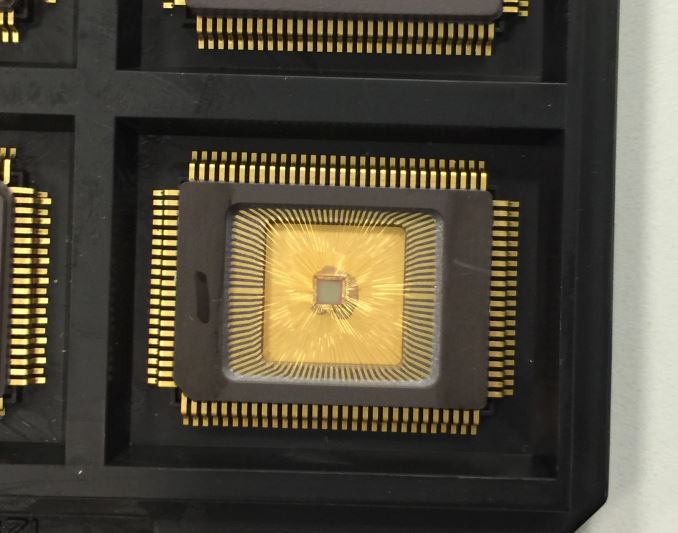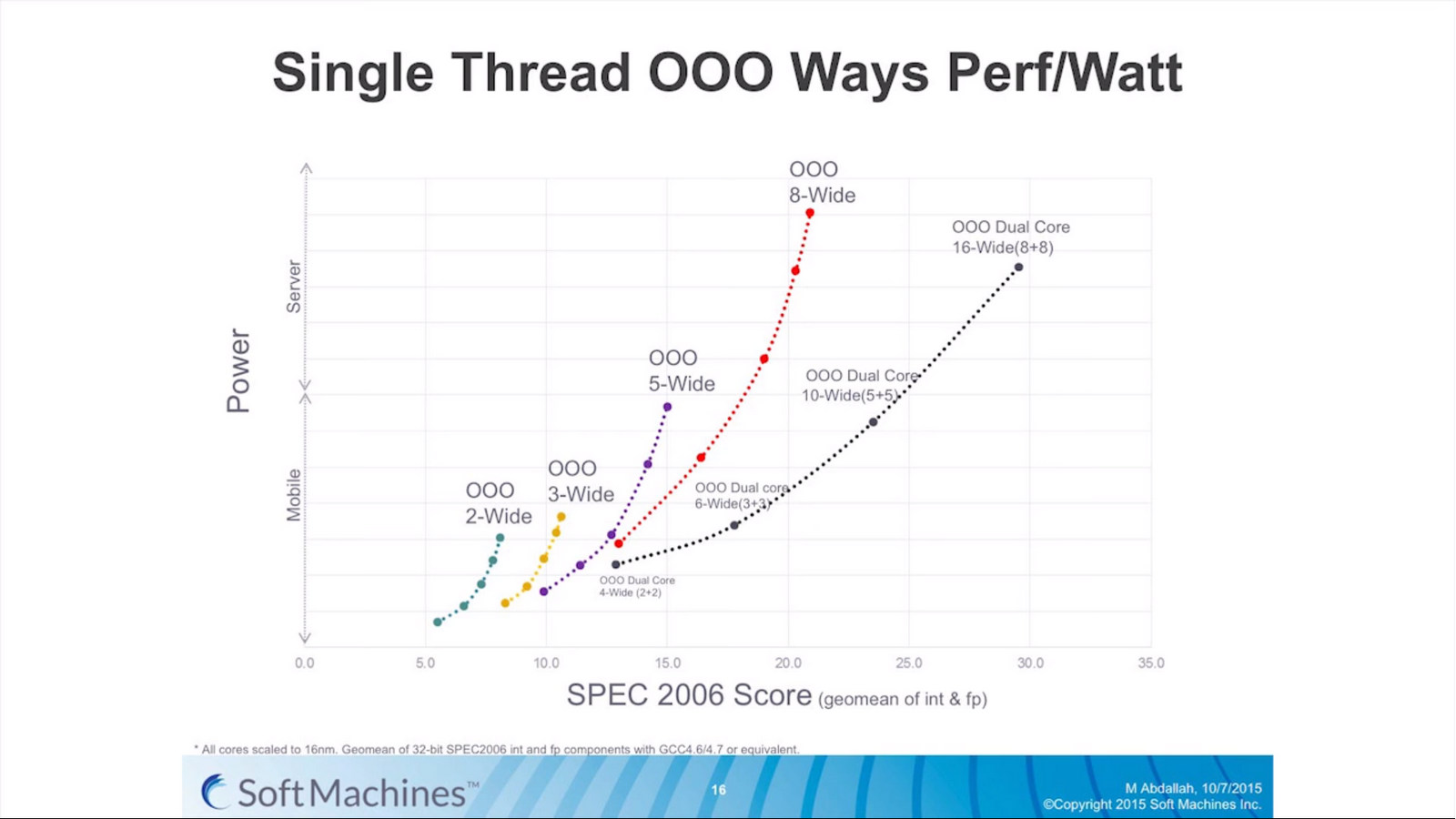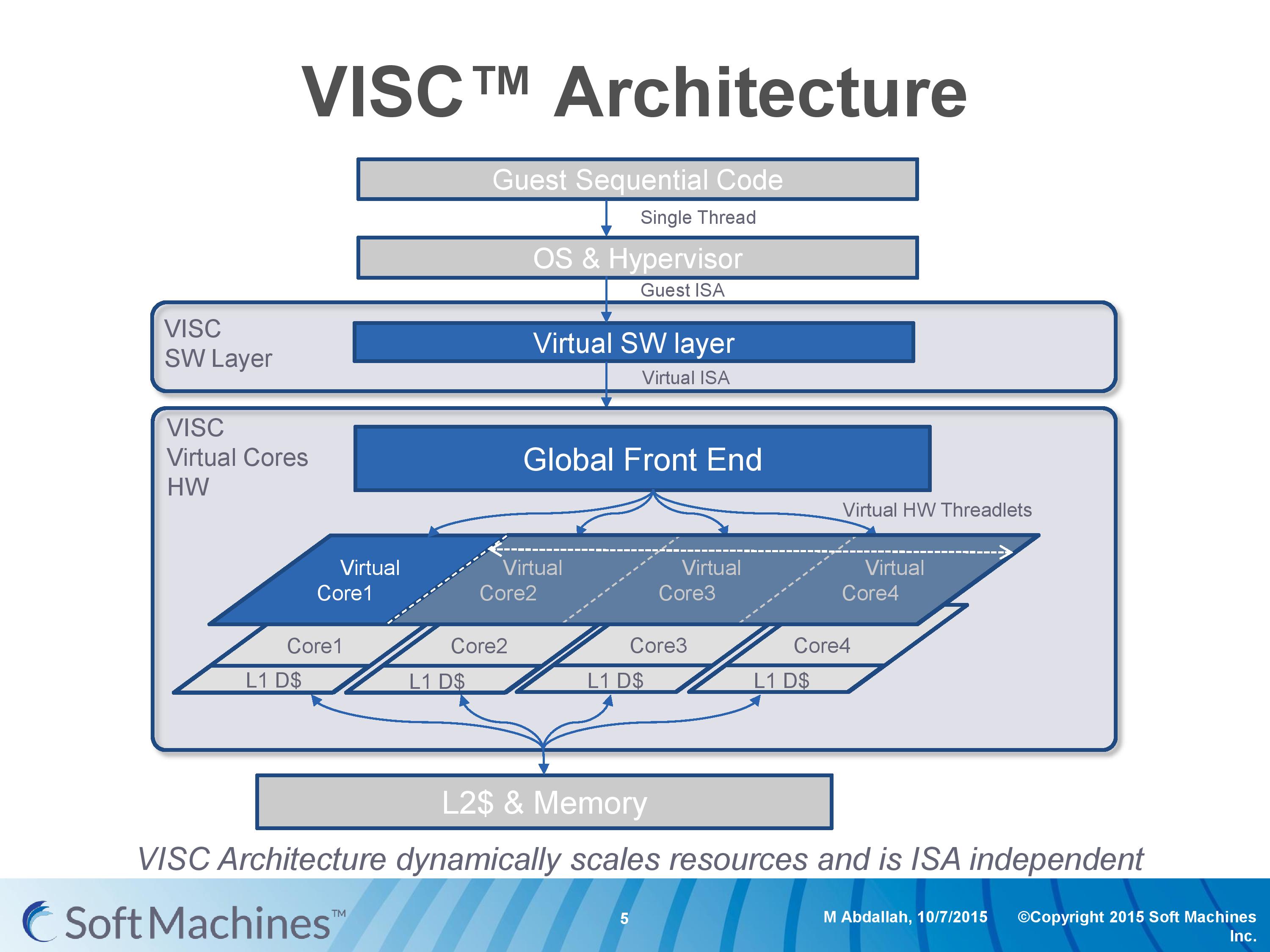Examining Soft Machines' Architecture: An Element of VISC to Improving IPC
by Ian Cutress on February 12, 2016 8:00 AM EST- Posted in
- CPUs
- Arm
- x86
- Architecture
- Soft Machines
- IPC

Last week, Soft Machines announced that their 'VISC' architecture was available for licensing, following the announcement of the original concepts over a year ago. VISC, in a nutshell, is designed as a solution to improving the number of instructions per clock a single thread can process in a given time, which potentially makes it a very interesting design in an era where IPC gains are harder and harder to realize.
The concepts behind their new ‘VISC’ architecture, which splits the workload of a single linear thread across multiple cores, are intriguing and exciting. But as with any new fundamental change in computer processing, subject to a large barrage of questions. We were invited to a presentation and call with the President and Chief Technical Officer Mohammed Abdallah and the VP Marketing and Business Mark Casey, and I put a number of questions on the lips of analysts to them.
Identifying Single Thread Performance Bottlenecks
Any discussion about processor performance over the last couple of decades has involved several factors, including getting better performance through an increased power budget, a higher frequency, extracting instruction level parallelism (ILP), getting better at minimizing delays through better branch prediction, or adding more cores and improving thread level parallelism (TLP). Each of these methods have varying degrees of success at increasing performance – long-time readers will remember the Pentium 4 days of hitting a frequency and power wall which then switched the focus to efficiency. Some tasks, like graphics, are inherently parallel and can take advantage of multiple hundreds or thousands of cores, or the software can be optimized. However, the nature of most software code and instructions is that they are single threaded by nature, and their performance relies on how fast the instructions can be processed within a single thread.
The main way of increasing performance, or in this case the instructions per unit frequency (instructions per clock, or IPC), is to expand the CPU architecture to allow more commands to be processed at once. Moving from a 3-wide out-of-order architecture to a 5-wide out-of-order architecture theoretically allows for a 66% increase in instruction throughput if (and only if) the code is sufficiently dense enough to extract those operations, and the other features in the architecture can ensure all the operations are fed every clock cycle.
The problem with moving to a wider architecture is typically power and design complexity. As shown by various chip designs over the years, the wider the architecture the more silicon has to be set aside for assets like buffers, re-order windows and caching. If there is a silicon budget and enough power headroom, we see designs like the six-wide Intel Skylake cores or the seven wide NVIDIA Denver cores able to extract peak performance when code is written that matches the hardware. However the potential downside of a wide architecture is that it remains inefficient for sets of instructions that only need a 2-wide or a 3-wide architecture. Alternatively, if multiple programs or threads want to use the hardware, then a single core is inaccessible to additional threads while the first thread is still in use (though this can be avoided somewhat by simultaneous multithreading or SMT which will let another thread have access when the first has encountered a stall such as waiting for L1/L2 memory).
As a result, modern designs also include a number of cores to handle the multile thread/multiple program scenario. Generally speaking this works well, especially with high-performance cores, but it becomes a bit of an issue itself when much of the world’s hardware is actually composed of many cores that have poor single threaded performance. Older Core 2 / Conroe systems, basic Bulldozer, or ARM Cortex-A7 designs are (still) widely used and often ship with multiple cores to allow for multiple programs at once. And while they can scale up with additional threads to the number of cores they offer, if any single or lightly-threaded software needs more performance, those extra cores are not used or are only minimally beneficial overall.
This brings us to Soft Machines, whose VISC architecture aims to change this.
Meet VISC
I should start by saying that despite the similarities to other architectural names, VISC is not an acronym. I asked directly and it is merely a noun for the purposes of trademarking. People can interpret it as a ‘virtual instruction set computing’ or something similar, but the company doesn’t apply any acronym to the letters.
But a virtual instruction set is a good description here. For the most part, processor architectures were traditionally built around either CISC (complex) or RISC (reduced) instruction sets and execution models, while more modern designs (e.g. Intel Core) are increasingly a mix, or so-called ‘CRISC’ design. The difference between CISC and RISC boils down to the fact that simpler designs can be more power efficient, but complex designs can do more complicated things in fewer cycles, all the while CRISC essentially meets the two paradigms in the middle in an attempt to gain the benefits of both, though not without inheriting some of the drawbacks as well. VISC, for lack of a better description, is a RISC design using a custom instruction set over a translation layer which allows a single thread of operations to be dispatched over multiple physical cores. The base diagram looks something like this:
Here is an example of a VISC design with four physical cores. The design can handle four ‘virtual cores’ or threads as well, but what makes the VISC design different is that when the virtual core has a thread of instructions, it can use the resources of any physical core. Thus, if each physical core is a 4-wide out-of-order design, if a thread running on a virtual core can utilize the resources of all four cores essentially making a giant 16-wide design, then under VISC can do so.
This should instantly throw up a number of questions on ‘What!? How?! Why?! Power? Frequency? Performance? Efficiency? Complexity?’ and as well as many others in the industry, we had the same questions.












97 Comments
View All Comments
Bleakwise - Tuesday, March 14, 2017 - link
"Floating point code""Integer code"
Do you have any idea what you're talking about?
Bulldozer does "flaoting poitn code" faster than the fucking 1080Ti
At least one one thread. Unless you're going to go wide it doesn't help.
The point of this isn't to "go wide" it's to massively increase speculation ability.
The 1080Ti has ZERO speculative ability, NONE. GPUs simply don't do branching, that's not what GPUs do, they rely on ACE units and SMX units and so on to balance thousands of cores.
A CPU on the other hand has more speculative branches than cores.
SIMD and SIMT that GPUs do are not "FPU code"
FFS
dcbronco - Friday, February 12, 2016 - link
AMD helped finance this. They may already have a stake and I would bet some right to first refusal. They used their investment in HBM to get earlier access than NVIDIA, I doubt they would have invested without some sort of incentives for themselves.Bleakwise - Tuesday, March 14, 2017 - link
Of course not.bcronce - Saturday, February 13, 2016 - link
There is no such thing as a free lunch. They are trading something. Their benchmarks are for single thread performance, which the graphs showed a much greater efficiency and performance than Intel. Very impressive and I'm sure they'll be great for something.The problem is the platform sounds great for highly coupled cores and very wide single thread execution with few data dependencies. Could be great for computation.
What I'm wondering is how their platform scales for IO workloads like web servers, file servers, or event video games. Suddenly a large part of the work is communicating with other devices and synchronizing many cores.
One thing that has helped ARM for a long time is they were mostly single core and only recently multi-core. They didn't use to have a complex cache-coherency like x86. This dramatically reduced transistor counts, increase efficiency, and allowed for great decoupled core performance. But as soon as you wanted two cores to work together, it went to crap. Cache-coherency is hardware accelerated inter-core communication. Amdahl's law was not very forgiving to ARM's non-cache-coherency cores for anything except GPU like workloads.
Based on the description, VISC sounds like it needs highly couples cores to maintain low latency and high bandwidth. This is probably why they also seem to have lower frequency. Keeping many parts far away from each-other in sync takes time. But lower frequency also means lower voltage, and power consumption scales with the square of the voltage and linear with frequency.
I wonder how tightly coupled they can keep 4, 8, or 16 cores. Maybe they don't need the core counts for their target workloads or possibly they can stay competitive with a fraction the core counts by having better efficiency in power and IPC.
In the end, I'm sure they'll at least find a niche market and I'm glad some new ideas are making it out there. I wouldn't be surprised if they can take over the dual or quad core market, forcing Intel to add more cores.
Bleakwise - Tuesday, March 14, 2017 - link
It's not a "free lunch"Obviously all of this crap is going to cost DIE space, it's not free.
If all we cared about was raw processing power we'd just make 2046kb wide vector units and ignore branching and speculation all together.
Bulldozer has better theortical performance than Haswell i5s. I'd rather have the extra out of order pipes, the SMT unit to use any unused pipes, better branch prediction and so, and in the real world this stuff wins the day.
Not everyone can become a world class programmer and re-factor all their code so that it spreads across thousands of cores like it can on a GPU.
Sometimes it's not even possible. Sometimes what you need is branch prediction, branch prediction lets you see the future, LITERALLY this is what the CPU does. Obviously the more branches you predict, the more cycles you're wasting on that thread, because the more speculations you get wrong.
You also reduce the number of misses and increase cache hits.
As for coupling 4 or 16 cores, they haven't even talked about going beyond 4 cores. Obvoiusly it doesn't scale into infinity, if you're getting 90% speculative accuracy you can only gain 10% more. Spending 30% of your transitor budget to bind up 8 or 16 cores when spending 10% of your budget on 4, for a 10% performance gain would be dumb.
You'd be much better off going for more clock speed, or reducing latency, adding a victim cache, or l2 cache coherency, or beefing up the GPU, a better memory controller, or just beefing up your underlying branch predictor,
Bleakwise - Tuesday, March 14, 2017 - link
You'll never get perfect speculation anyway. Unless a language is developed that puts limits on the number of branches possible per X lines of code and keep the number of branches below the number the CPU can handle. You're going to ALWAYS have to deal with the risk of cache misses.Not sure there is even anything you could gain from 100% target prediction hit grantee beyond having no lost cycles on a miss. Getting there even through a core-binding fabric/bus like this across 16 cores would blow your transistor budget to the point that you could hardly afford a reasonable size cache in the first place.
You'd be better off just reducing the number of stages in the pipelines or just adding more pipelines to each core instead of blowing your budget on this fabric.
For example, binding together 100 in order CPUs to make a virtual 100 pipeline CPU would be ridiculously expensive and power hungry vs just having an 8 core superscaler CPU with 12 out of order pipelines in each CPU.
tipoo - Friday, February 12, 2016 - link
Question, since this is testing their core design in isolation and the rests of the package hasn't been built around it, is that accommodated for in the comparisons to other SoCs, which all have far more die area dedicated to non-core stuff than the cores?Flunk - Friday, February 12, 2016 - link
If VISC is not an Acronym then don't capitalize it, idiots.The technology looks like it could be really good, I'm hoping we see some practical applications.
smilingcrow - Friday, February 12, 2016 - link
They can capitalize it for any reason they like; it's just a word so nothing to GYKIATO (Get your kickers .... over).andychow - Friday, February 12, 2016 - link
It's an acronym, you can't trademark acronyms, so now they claim it's not an acronym. Legal bs 101.